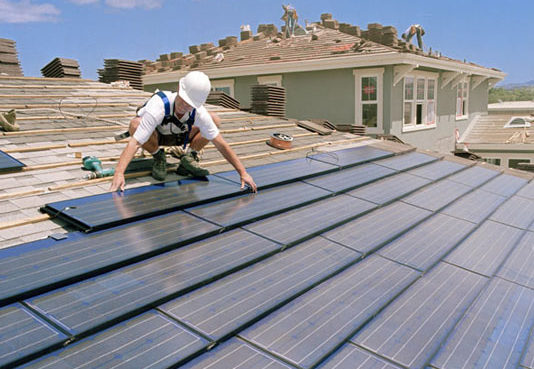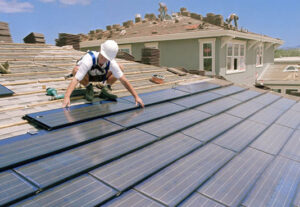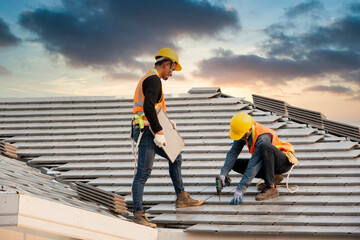Roofers Cape Coral install, repair, and replace the roofs of buildings. Their work is important because it protects people and their possessions from the elements. Roofers must be skilled at working with different types of materials and follow safety guidelines when performing their duties.
These workers may also perform other types of construction on structures, such as siding and windows. Roofers often encounter dangerous conditions, including steep-slope roofs, so they must be careful when navigating these environments.

Roofers are realistic individuals, meaning they’re independent, stable, persistent, genuine, practical, thrifty, and like tasks that are tactile, physical, athletic or mechanical. They typically don’t enjoy tasks that are sedentary or intellectual.
Large retail sales roofers have a customer service department and multiple crews to handle large jobs, insurance claims, and regular repairs. These companies typically have access to a variety of materials, and their pricing is often negotiable. The sales presentations are lengthy and may present the highest-priced options first — expect to negotiate hard.
Storm chasers are roofing contractors that follow after big weather events. They’ll drive around and knock on doors, offering to check for roof damage. They’ll often help with the insurance process and offer zero-percent financing. Depending on the area, they may also do normal roof repair and inspections for real estate companies. They’re not a good choice if you want to work with a local roofer.
A storm chaser is a term used in the roofing industry for roofing contractors who travel to areas that recently experienced heavy hail and wind storms. They go door-to-door to try to convince homeowners they have roof damage and need a new roof. They often offer to take care of the insurance deductible for the homeowner, which can sound very tempting.
If you’re a homeowner experiencing roof damage after a big storm, it’s natural to feel vulnerable and want your home repaired quickly. However, when hiring a roofer to work on your home, make sure you’re working with a reputable local company. There are many reasons why roofers hate storm chasers.
They usually don’t have a local office or long-standing reputation in the area. They may use high-pressure sales tactics and fail to explain all of the terms in their contract with the homeowner. If you have any doubts about their integrity, it’s important to check out the company online and ask for references from past clients.
Most of the time, these contractors are merely opportunists who look for low-hanging fruit after a major weather event. They do not have the same level of expertise as a reputable local roofing contractor and they may not adhere to local codes or roofing standards. They are also likely to complete a rush job on your roof, which can lead to problems down the road.
They often offer limited-time pricing to pressure homeowners into signing a contract right away. It’s important to remember that you should always compare prices and quality of workmanship with multiple roofing contractors. A good roofing contractor will understand the market value of your home and provide a competitive price that is fair to both you and them.
Another thing to consider is that many storm chasers are not properly licensed or insured. They may also be working with subcontractors that are not qualified to perform the work on your roof. This can be a huge liability for you as a homeowner. And, if you’re dealing with a storm chaser, chances are they won’t be around to help you if there are any issues after the project is finished.
Some of the most common workplace injuries that roofers face involve ladders, slippery roofs and power tools. Roofing workers should wear goggles or safety glasses to protect their eyes from dust and chemicals. They should also wear earplugs or earmuffs to reduce the risk of hearing damage. They should also wear gloves when handling roofing materials to prevent cuts. They should also wear sturdy footwear that provides good traction.
Ladders can be very dangerous for roofers, especially if they’re not secured properly. They should have slip-resistant rungs and be rated for the weight of the worker and any equipment they might be carrying. Roofers should always climb a ladder facing the direction of travel, and they should keep three points of contact with the ladder at all times. They should also avoid carrying heavy materials up a ladder, as this can lead to physical injury.
Fall protection is another essential requirement for roofers. This includes a body harness with a lanyard that connects to a solid structure or anchor point on the roof. This system is called a personal fall arrest system (PFAS). It’s essential that roofers have this gear and wear it at all times while on the job.
In addition to fall protection, roofers should use a harness and lanyard, a hard hat, and a rope or wire barrier. A rope or wire barrier is used to prevent workers from entering unprotected areas of the roof. It should be capable of withstanding at least 500 pounds of pressure.
Other safety requirements for roofers include a safe work area and adequate ventilation. The worksite should be free of debris, and roofers should always walk in a well-lit area. They should also take steps to prevent electrical hazards by covering live wiring with insulating covers and avoiding contacting electricity. The worksite should also have appropriate lighting for working at night.
Roofers work with a team, and their schedule can change depending on weather conditions. During peak seasons, they may work overtime to meet demand. In addition, they often have to wait for materials to arrive at their job sites. This can make it difficult to meet deadlines for completing projects.
As part of their duties, roofers inspect problem roofs to determine the best repair procedures. They also remove snow, water, or debris from roofs and prepare surfaces before applying roofing materials. They also set up scaffolding to provide safe access to roofs, and they estimate the materials and labor required for each roofing job. Additionally, they cement or nail flashing strips of metal or shingle over joints to make them watertight.
Roofers typically receive on-the-job training to learn the skills of the occupation. They start out by learning how to use tools and equipment, then they move on to learn about various types of roofing systems. They may install asphalt or fiberglass shingles, and they can also apply other types of roofing material.
Because roofers spend most of their time on the roof, they must be careful to keep themselves safe. They should avoid falling off the roof, which can cause serious injuries. To prevent falls, they should wear sturdy shoes and use a harness. They should also avoid exposing themselves to the sun, which can lead to heat exhaustion and dehydration.
Another thing to remember is that roofers work with a lot of power tools. This creates a lot of noise, which can disturb anyone in the house, including children and pets. They should try to keep the noise down as much as possible. They should also take extra precautions during multi-day jobs, such as protecting sensitive areas overnight.
Despite the fact that roofers do not interact with customers very much, they should have good communication skills. They must be able to discuss details about the project with team members, and they should communicate with the customer to ensure that all requirements are met. In addition, they must know how to read and understand blueprints and other technical documents. Finally, they must be aware of the latest roofing technologies and safety rules.






